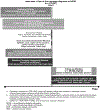ASSOCIATION OF DIAGNOSIS CODE-BASED AND LABORATORY RESULTS-BASED KIDNEY FUNCTION WITH DEVELOPMENT OF VISION THREATENING DIABETIC RETINOPATHY
- PMID: 32500786
- PMCID: PMC7572525
- DOI: 10.1080/09286586.2020.1773869
ASSOCIATION OF DIAGNOSIS CODE-BASED AND LABORATORY RESULTS-BASED KIDNEY FUNCTION WITH DEVELOPMENT OF VISION THREATENING DIABETIC RETINOPATHY
Abstract
Purpose: To determine how kidney function identified by diagnosis codes compares to lab results-based kidney function for predicting the risk of vision-threatening diabetic retinopathy (VTDR).
Methods: A US medical claims database was used for this retrospective observational study. Adult patients enrolled from January 1, 2002 to December 31, 2016 with nonproliferative diabetic retinopathy (NPDR) were followed. Patients were excluded if they had any previous diagnosis or treatment of VTDR or VTDR diagnosed within 2 years of insurance plan entry. ICD9/10 Chronic kidney disease (CKD) diagnoses from outpatient claims were used to classify kidney disease with or without end-stage renal disease (ESRD). Serum creatinine was used to calculate estimated glomerular filtration rates (eGFR). Multivariate Cox models with time-dependent covariates were used to assess the associations of kidney disease diagnosis and eGFR with progression to VTDR, controlling for demographics and time-dependent covariates (systemic health, laboratory results, insulin use). C-statistic (a measure of model discrimination), hazard ratio (HR) and their 95% confidence intervals (CI) were calculated from multivariate Cox models.
Results: Among 69,982 patients with NPDR, 12,770 (18.2%) developed VTDR. C-statistic was identical (0.60, 95% CI: 0.59-0.60) for the multivariate model with eGFR and for the multivariate model with kidney diagnosis codes. eGFRs lower than 30 mL/min/1.73 m2(HR>1.14, p < .02 for all comparisons), and a diagnosis of ESRD (HR = 1.07, p = .02) were associated with higher risk of progression to VTDR.
Conclusions: Both diagnosis-based and lab results-based kidney function were associated with the development of VTDR and predict the development of VTDR equally well.
Keywords: chronic kidney disease; claims data; diabetic retinopathy; pharmacoepidemiology.
Conflict of interest statement
Conflicts of Interest: No conflicting relationship exists for any author.
Figures
References
-
- Hsieh Y-T, Tsai M-J, Tu S-T, Hsieh M-C. Association of Abnormal Renal Profiles and Proliferative Diabetic Retinopathy and Diabetic Macular Edema in an Asian Population With Type 2 DiabetesAssociation of Abnormal Renal Profiles and Proliferative Diabetic RetinopathyAssociation of Abnormal Renal Profiles and Proliferative Diabetic Retinopathy. JAMA Ophthalmology. 2018;136(1):68–74. - PMC - PubMed
-
- Lau M, Prenner JL, Brucker AJ, VanderBeek BL. Accuracy of Billing Codes Used in the Therapeutic Care of Diabetic RetinopathyAccuracy of Billing Codes Used in Diabetic Retinopathy TreatmentAccuracy of Billing Codes Used in Diabetic Retinopathy Treatment. JAMA Ophthalmology. 2017;135(7):791–794. - PMC - PubMed
Publication types
MeSH terms
Substances
Grants and funding
LinkOut - more resources
Full Text Sources
Other Literature Sources
Medical
Research Materials
Miscellaneous

